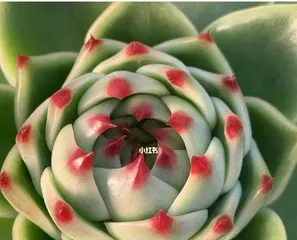Red-claw succulents, with their vibrant colors and unique shapes, have become a favorite among many succulent enthusiasts. However, many people encounter various problems when caring for Red-claw succulents, such as not knowing how to water, fertilize, or prevent pests and diseases. This article will provide a detailed introduction to the care methods for Red-claw succulents, hoping to help everyone.

I. Understanding Red-claw Succulents
1. Classification of Red-claw Succulents
Red-claw succulents belong to the Crassulaceae family and are relatively easy-to-grow succulent plants. Red-claw succulents are mainly divided into 5 varieties, including "Rose", "Lingzhi", "Purple Flower", "Colorful", and "Golden Hook".

2. Characteristics of Red-claw Succulents
The leaves of Red-claw succulents grow in clusters, are slightly thick, and have vibrant colors, which can range from red, purple, to orange. They also have unique characteristics such as being juicy, drought-tolerant, cold-resistant, and highly adaptable.
II. Care Methods
1. Choosing the Right Soil

Red-claw succulents prefer loose, well-aerated, and well-draining soil. You can add loose materials like perlite or small stones to the substrate to increase aeration, while ensuring the substrate is not too moist.
2. Watering
Red-claw succulents need moderate water during their growing season, but they should not be soaked in water. Generally, water again only after the soil surface has slightly dried to avoid overly damp soil.
3. Fertilizing
Red-claw succulents need a moderate amount of nutrients during their growing season, but over-fertilization can cause excessive growth and make the plant more susceptible to pests and diseases. You can apply a moderate amount of organic fertilizer in spring and summer.
4. Avoid Excessive Shaking
When moving or placing Red-claw succulents, handle them with care to avoid excessive shaking and collisions, which can damage the leaves.
5. Light
Red-claw succulents love a well-lit environment. They can be placed on a bright indoor balcony or in a partially shaded outdoor area, but avoid direct, intense sunlight.
6. Temperature
Red-claw succulents prefer a warm and dry environment, with an ideal growing temperature of 15°C to 30°C. Temperatures that are too high or too low will affect the plant's growth.
7. Pruning
Red-claw succulents produce a large number of leaves and small branches during their growing season and need to be pruned in time to maintain the plant's shape and aesthetic appeal.
8. Pest and Disease Control
Red-claw succulents are susceptible to pests and diseases such as aphids and whiteflies. Timely measures should be taken for prevention and control, such as spraying insecticides or increasing ventilation.
III.
The care methods for Red-claw succulents are not complicated. By paying attention to some basic principles, you can easily create healthy and beautiful Red-claw succulents. It is hoped that this article will be helpful. Caring for Red-claw succulents requires patience, care, and love. Believe that if we nurture them with our hearts, we will reap unexpected rewards.